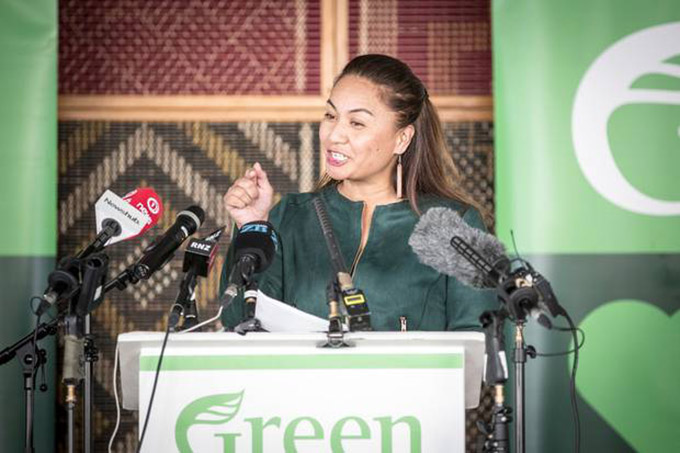Eden created an online series for Te Karere voicing the political views of youth. Video: AUT
By Michael Neilson, Māori affairs reporter of the New Zealand Herald
Advocates for boosting te reo levels in Aotearoa say it provides a gateway to greater cultural, historical and racial understanding.
Minister for Crown/Māori Relations Kelvin Davis says he would love to see all New Zealanders feeling comfortable in Māori spaces, with te reo Māori being the key.
“To go on marae and feel comfortable, engage in things like Waitangi Day, Kororneihana, and Rātana. It is only daunting when there is ignorance and lack of understanding about what is going on.”
Davis says Te Tiriti o Waitangi is a “bridge” connecting te ao Māori and Pākehā, with language, customs and culture on each side.
“Since 1840 who has crossed that bridge? Māori have crossed over, how many have come back the other way? Some people have, and we are really grateful for that, but it has been one-way traffic mainly.”
Due to that one-way traffic, and consequent ignorance of Māori language and culture, there is often tension. Learning te reo would help reduce the ignorance about Māori issues, and what it is to be Māori, Davis says.
Growing up in a monolingual household, Davis, of Ngāti Manu descent, said he felt “something was missing”.
‘Felt embarrassed’
“I felt embarrassed going on to our marae, not knowing what was being said.”
He took it up at high school, maintaining it through his adult life. He said he was about a “7.5 out of 10” in terms of fluency.
Speaking Māori gives confidence in who you are as Māori New Zealander, and leads on to other understanding of whakapapa, and history, Davis said.
“It is hard to engage in te ao Māori without knowing the language. You can know tikanga, customs, attitudes, but the cream on top is te reo.”
Head of Auckland University of Technology’s School of Language and Culture, Associate Professor Sharon Harvey, says learning a second language helps people understand different points of view.
“If New Zealand had embraced Māori earlier on we would be seeing the benefits of seeing things from different perspectives. Our determined rejection has not helped.”
Te reo Māori is closely linked to other Pacific languages.
Pacific access
“It gives access to Pacific languages like Tahitian, Cook Island Māori, and a little more distant to Tongan and Samoan.”
While New Zealand promotes itself as being bicultural, it has never extended that ambition to being bilingual, Dr Harvey says.
“I think Māori would say the intent of the Treaty was never for the language of this land to be lost, and replaced with a language from the other side of the world. We really can’t be bicultural unless we are bilingual.”
 Green Party co-leader Marama Davidson says her grandmother had te reo “beaten” out of her. Image: Michael Craig/ New Zealand Herald
Green Party co-leader Marama Davidson says her grandmother had te reo “beaten” out of her. Image: Michael Craig/ New Zealand Herald
Green Party co-leader Marama Davidson says te reo is a “core” part of the future of race relations in Aotearoa.
Davidson’s grandmother had literally had the language beaten out of her, and it had taken three generations to get over the trauma.
“Her children didn’t learn, and neither did we, and now it has taken our children to finally reclaim it.
“Te reo is core to healing, core to the future of our race relations. It gives us something unique, to be proud of, together.”
Adult learning
Davidson (Ngāti Porou, Te Rarawa and Ngāpuhi) started learning te reo properly as an adult, and even made a decision to only speak te reo to one of her daughters – now 10 – since birth.
Te reo offers an insight to the Māori worldview, offering different perspectives, Davidson says.
“Things like there being no gender pronouns in te reo, in itself says something profound about accepting or rejecting narrow sexual identities.
“Another example is mokopuna, which literally means wellspring of descendants. Te reo offers the opportunity to understand those things.”
National’s Māori development spokesman Nuk Korako says te reo is like the country’s “flora and fauna”.
“It is like the kauri – it is unique, rooted in this country’s fabric. Why wouldn’t we want to learn te reo?”
Korako, of Ngai Tahu descent, grew up in a monolingual household, with parents part of the generation “not allowed to speak Māori”.
Te reo compulsory
He learned his reo at St Stephen’s College in Bombay, south of Auckland, where te reo was a compulsory subject.
“I remember on my first day there were guys from Tūhoe having a conversation in te reo. I had heard it on the marae growing up, but it was fascinating to hear it in a daily context.”
He says increasing cultural and history understanding would foster interest in te reo.
“One of the most important things with rangatahi in New Zealand, is that they have a really good understanding and grounding of Māori culture and history, because it then gives them that appreciation to the language of the culture.”
Te Taura Whiri (Māori Language Commission) chairwoman Professor Rawinia Higgins says learning te reo would give Kiwis a better understanding of who we are as a nation.
“It is our first language, so helps define who we are. It is also a defining feature of who we are in a global context.
“A significant feature of our national game is the haka, and that is in te reo. On the international stage people are interested in it for that unique element.”
Higgins, who is also Victoria University of Wellington’s Deputy Vice-Chancellor (Māori), says language and culture go hand in hand.
“With te reo, Te Tiriti comes into it as well. It helps open up a different perspective over some of our historical encounters, and move forward overall.”
This article is republished from the New Zealand Herald with permission.
Article by AsiaPacificReport.nz
]]>








